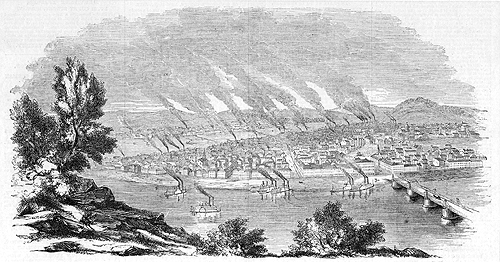The Point: 1855

CAPTION: The Point, 1855.
NOTES: Engraving.
A closeup of The Point from this engraving.
"The engraving [above], drawn expressly for the Pictorial,
presents an accurate general view of this flourishing city,
interesting from its present commercial importance and from
historical associations. In 1850 it contained 46,500 inhabitants,
but the annexation of the adjoining cities and boroughs of
Alleghany, Manchester, Birmingham and Lawrenceville, which ought
to belong to it, would more than double that amount. It stands at
the junction of the Alleghany and Monongahela Rivers, which unite
to form the Ohio, and occupies the site of Fort du Quesne. In 1775
there were but twenty-five or thirty houses in Pittsburg.
In 1796 the population amounted to 1395.
"The city is built on a triangular plain, bounded by the
Alleghany and Monongahela Rivers on two sides, and by the highlands
on the other. The streets cross each other at right angles. The houses
are principally of brick, and many of them are handsome structures, but
owing to the extensive use of bituminous coal in the numerous manufactories,
the city resembles an English town in its dinginess. The Alleghany River
is crossed by three bridges. The bridge over the Monongahela is 1500
feet long and cost over $100,000. The Alleghany River, besides the
bridges above named is crossed by the viaduct of the Pennsylvania
Canal, which enters the city, passes through a tunnel under Grant's
Hill, and then joins the Monongahela. Another branch of the canal passes
through Alleghany City and enters the Allegheny River. Among the noted
works constructed by the city are the water-works. Steam power is used
to raise water from the Alleghany River into a reservoir, to the height
of 116 feet, from which, by means of service pipes, 3,000,000 gallons
are daily distributed. Pittsburgh is lighted by gas made from
bituminous coal, abundant in the neighborhood, and presents a brilliant
appearance at night.
"The situation of the city has led to its rapid
progress and importance. The railroad and canal line from Pennsylvania
strikes the Ohio at this point. Here was launched in 1811 the first
steamboat that ever ploughed the western waters. Among the striking
buildings of the city proper is the court house, which stands upon an
eminence commanding an extensive view. Its architecture is the Doric
style, and it is a fine specimen of that order. It is 165 feet long
and 100 feet deep, and surmounted by a dome, the summit of which is
148 feet from the ground. The Roman Catholics have a fine cathedral
on Grant's Hill. There are other public buildings, churches, hotels
and banks, noted for their costliness and elegance. The Museum is
well worth visiting for its ample collection of Indian curiosities.
There are three market houses in the city, all well supplied with
meat, poultry and fruit, and other agricultural products. The
Western University of Pennsylvania is situated near Grant's Hill.
"Alleghany City, on the opposite side of the Alleghany River,
is a very flourishing place, and though under a separate corporation,
virtually belongs to Pittsburg. It is the residence of many of the
business men of the latter place. It has many manufacturing and
commercial establishments, which are extensive and thriving, and
numerous churches and schools. Here is the Western Theological
Seminary, under the direction of the Presbyterians. It is a
flourishing institution, and has two professors and a well selected
library. The Theological Seminary of the Associate Reformed Church
is also here.
"Pittsburg was part of Penn's property, and was, in 1784,
in possession of the family of that illustrious man. Up to that time
the settlement had languished, but at that date it was laid out into
town lots, and land began to sell rapidly. In 1786 a newspaper called
the Pennsylvania Gazette, was started here. We are not aware that this
paper is still in existence. If Pittsburg has not grown quite so
rapidly as some more modern settlements farther west, still its
progress has been rapid, and outstripped by very few. Men are still
living who remember it as an inconsiderable village, and it is now
a great city, having within it all the elements of yet greater
expansion. In the mineral resources of the environs it has an unfailing
treasure; nature and art have rendered it accessible in many ways, and
its position at the head of that mighty river which wends its way to the
west, freighted with incalculable wealth, gives it an importance which
can hardly be overrated. It is a curious fact that the physical
formation of this country is peculiarly adapted to its social
development. Its great rivers flow inward, and afford the opportunities
of bringing far distant points into communication. Pittsburg stands
at the head of the natural communication with the centre of States,
while art has given to it numerous channels of communication with
the Atlantic shore.
[Precise source for this engraving and accompanying description is unknown.]
PHOTOGRAPHER:
DATE: [1855].
HEADING:
#:
From the Collections of the Pennsylvania Department,
The Carnegie Library of Pittsburgh.
 mages 1.
mages 1.
 arrative.
arrative.
 utline.
utline.
 eighborhoods.
eighborhoods.
 ain Menu.
ain Menu.

